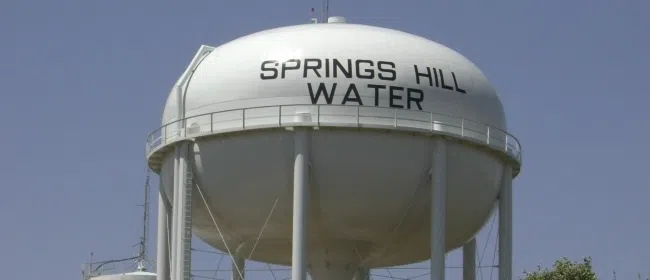(Seguin) — A letter sent out recently by Springs Hill Water Supply has some people in the Seguin area wondering if the water is safe to drink. Those concerns ultimately led to the city of Seguin addressing the issue, which impacts some of its residents. City officials say they also wanted to reassure everyone that the city’s own water supply is safe, and that Springs Hill’s water is also safe to consume.
Tim Howe, director of water and wastewater utilities, provided some insights during Tuesday night’s regular meeting of the Seguin City Council. The item wasn’t on the agenda, but Howe wanted to address some of the concerns that were received by city officials, even though the letter had nothing to do with the city’s own water service.
“Springs Hill Water Corporation published a notice regarding water quality within their public water system. That generated some concerns and questions for our citizens. So, I just wanted to take this time to speak about that,” said Howe.
The notice from Springs Hill included some technical language as required by federal and state standards. That language may have unfortunately led some people to think that the water from Springs Hill was unsafe.
“In their notice, they reported a total trihalomethanes concentration of 0.84 parts per million in the fourth quarter of 2024. The maximum contaminate level established by the EPA is 0.80 parts per million. So, 4 one thousandths above the maximum contaminant level,” said Howe.
The thing that some readers may have missed in the letter, was that the naturally occurring contaminant is only harmful in situations where there is long term high levels of consumption, which was not the case with Springs Hill.
“Total Trihalomethanes is commonly referred to as TTHM’s or a group of volatile organic compounds that occur when chlorine reacts with naturally occurring organic matter in the water and they can pose a health risk if exposed to those long term. Springs Hill customers do not need to seek an alternate water supply and Springs Hill is working to correct this issue,” said Howe.
Howe again stressed that the city of Seguin operates its own water service, but he wanted to address the issue because some city residents do receive their water from Springs Hill. Howe says all water providers have to meet federal and state guidelines for water quality, and if there are any problems, they have to be disclosed to the public.
“Just for clarification purposes, I wanted to point out that Springs Hill is a separate water provider in our community and serves citizens in our community from the city of Seguin’s water utility. The Seguin Water Utility is not experiencing any levels of TTHM above the maximum contaminate level. The city’s latest – it’s called the Consumer Confidence Report – we publish it once a year, the latest levels of TTHM’s in the Seguin water supply was reported at 0.61 parts per million and that’s for our surface water and for our groundwater supply, it was .0039 parts per million and I will just say real quick that in groundwater, you have less naturally occurring organic matter than you do in surface water so that’s kind of the reason why groundwater is really low. All public water systems are required by the state and the federal regulations to monitor the quality of our water in our distribution system and to notify our customers if there are any concerns,” said Howe.
Even though the item wasn’t on the council’s agenda, Mayor Donna Dodgen thanked Howe for helping the public better understand what was contained in the report from Springs Hill, and that the water was safe to drink.
A copy of the original letter from Springs Hill Water Supply can be found online at https://springshill.org/documents/577/2024_Mandatory_Language_for_a_Maximum_Contaminant_Level_Violation_MCL_LRAA_TTHM.docx.





